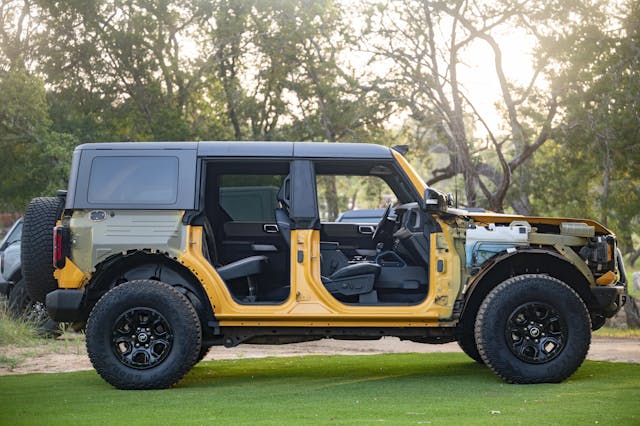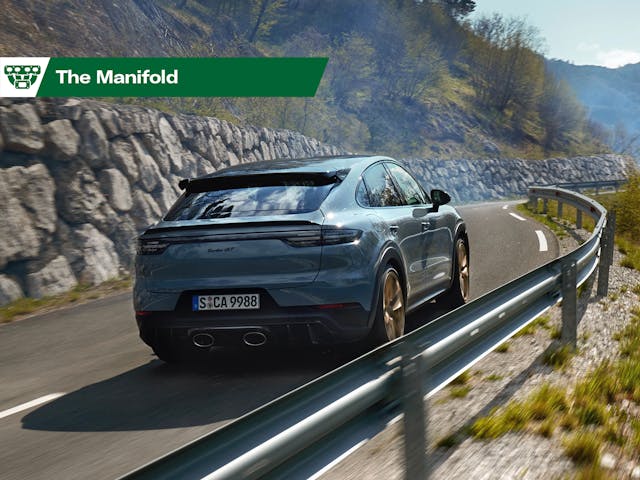Porsche’s 631-hp über Cayenne, factory heritage parts for Supra, Slovakian car takes to the skies
Welcome to The Manifold, our fresh daily digest of news and what’s happening in the car world.
Cayenne Turbo GT is a hefty, heroic track weapon
Intake: Porsche just unveiled a new sporting variant of its Cayenne SUV, the Turbo GT. It’s meant to be the crown jewel of the Cayenne lineup, with a ridiculously powerful twin-turbo 4.0-liter V-8 that boasts 631 hp and 626 lb-ft, gains of 90 ponies and 59 twists over the regular Cayenne Turbo Coupe. Performance figures are appropriately bonkers: 0–60 in 3.1 seconds, quarter-mile in 11.6, and top speed of 186 mph. Porsche’s deft tuning helped the Cayenne Turbo GT blitz the Nürburgring Nordschleife in just 7:38.9, a new official SUV lap record for the 12.9-mile full course. Expect to see it in dealer showrooms early next year, starting at $182,150.
Exhaust: This one’s gonna rip. Whenever Porsche aims its performance might at one of its models, the end result is almost always remarkable. For our money, we’re getting in line over at club 911 GT3, but as the Cayenne outsells the 911 by more than two to one, there’s a not insignificant chance this high-po variant outsells the spicier 911s by a similar margin. For our review of the Turbo GT prototype, click here.
Super summer news for A70/A80 Supra owners

Intake: Toyota’s GR Heritage Parts department has just announced a run of remanufactured spare parts for the A70 and A80 Supra, serving Japanese and North American enthusiasts. Available from Toyota dealers, while stocks last, will be a selection of components to keep these JDM classics on the road. The A70 is best served with a clutch master cylinder, clutch release cylinder, brake and heater hoses, A/C control-panel knob, front emblem, side-protection moldings, rear emblem, front door trim and front suspension lower arm bush being made available between July and August. The A80 will have its oxygen sensor and front bumper on sale at the same time.
Exhaust: Toyota Supras have an arsenal of fandom behind them, whether they’re selling for a Fast and Furious fortune or the waiting to their moment as is the A70. This factory support is great news and shows that big corporations can care!
Fancy a fly-drive in Slovakia?
Intake: A Slovakian professor has built a BMW-powered car that both drives and flies. It actually proved its capability by flying between Nitra and Bratislava—a distance of 60 miles. The AirCar runs on regular pump fuel and its inventor Professor Stefan Klein claims it can fly for 600 miles at up to 8200 feet. It takes just over two minutes to switch from air to ground mode, with its narrow wings performing a little ballet as they swing up, round and down to be stowed inside the body. The tail then retracts to shorten the vehicle’s length for driving on the road. In the air, the BMW engine powers a pusher propeller and, judging from the video of it in flight, the wheels seem to rotate as well. Sensibly, the prop gets disengaged for driving. Professor Klein says that he’s notched up 40 hours of air time so far and hopes to get it certified for commercial use soon.
Exhaust: We’ve been promised flying cars for decades, but there’s a real renewed interest right now, so hopefully this will be more than a fly-by-night effort.
How L.A. weather, a Wrangler, and a 21-year-old nanny influenced the 2020 Bronco’s door design

Intake: A dissatisfied Wrangler owner indirectly set Ford designers on a quest to optimize the open-air personality of its resurrected, sixth-gen Bronco, reports Automotive News. As a nanny living in Los Angeles, 21-year-old Bianca had every reason to enjoy the West Coast weather but no garage of her own in which to store her Wrangler’s doors after she removed them. Ford’s team rejiggered hinges, fiddled with mounting points, and even relocated the Bronco’s sideview mirrors in a painstaking quest to preserve the compact, agile shape of the 2020 Bronco while ensuring owners could easily unbolt and stow the doors in the truck—with factory-provided protective bags and rubber bumpers.
Exhaust: Ford’s design team showed its dedication to one-upping the Wrangler by tackling an ergonomic headache itself, rather than leaving it to the aftermarket. (Wrangler owners, if they aren’t willing to cram the doors into the rear seats, must get creative with garage-mounted racks or even a cart.) The Bronco’s stowable doors will give their owners bragging rights over Wrangler customers, and are a telling mark of how far the Bronco has come in six generations: The original base model, the roadster, didn’t even have doors—or a roof, for that matter.
Chevrolet confirms Silverado ZR2 with teaser video
Celebrating those who love the mud. Tune in this fall to see what's new from #Silverado. pic.twitter.com/MUYoEUyBZa
— Chevy Trucks (@ChevyTrucks) June 30, 2021
Intake: We’ve seen spy photos for quite a while, but this video confirms the wildest off-road trim for Silverado will follow in the footsteps of its compact, mid-sized brethren and wear the ZR2 badge. We can’t make out many details, but we do know that the rear suspension will be leaf-spring, as opposed to the Ram TRX and current-generation Raptor, which both use coils.
Exhaust: The Colorado ZR2 has made quite a name for itself, and it’s apparent Chevy feels that ZR2 is becoming a brand of its own. With the Raptor and TRX starting at $64K and $70K, respectively, Chevrolet might see a way to offer a more affordable entry to that level of full-size off-road capability. As it stands, Chevy offers the Trail Boss, the Silverado’s current top off-road package, in both Custom and LT trims, but on the Colorado, ZR2 is a trim of its own. If the fantastic off-road demeanor of the Colorado ZR2 is any indication, Chevrolet will have a serious competitor to the Raptor, but we doubt this Silverado will pack the kind of power needed to woo TRX buyers—at least, not at first.
Study puts EV and ICE carbon emission factors under the microscope

Intake: Reuters recently conducted an analysis on Argonne National Laboratory’s GREET (Gases, Regulated Emissions and Energy Use in Technologies) model, a resource used by the EPA and other regulatory bodies to shape government policy. Findings show that in general, producing an EV creates a greater upfront carbon footprint than a gasoline powered vehicle, primarily due to the amount of mineral extraction and processing required in EVs. Therefore, a certain amount of time or mileage must elapse until your traditional gas-powered car begins to outpace the carbon footprint of an EV. This is especially true when certain nations rely more heavily upon a coal-fired electricity grid. The analysis notes that a greener nation like Norway will achieve break-even sooner, as opposed countries like China or Poland that rely more heavily on coal. The two vehicles chosen by Reuters in their comparison were a Tesla Model 3 (54kWh), and Toyota Corolla (33 mpg). In the U.S., where 23 percent of the nation’s energy is derived from coal, one would have to drive the Corolla at least 13,500 miles (~1 yr) before the initial advantage over the new Model 3 was lost. In Norway, that number lowers to 8400 miles (~6 months). However, in China and Poland, where electrical charging is much dirtier, mileage climbs up to 78,700 miles (~5 yrs).
Exhaust: Quantitatively speaking, in the long run, there’s plenty to like about the oncoming EV movement by the numbers for the environmentally attune. However, while there’s no denying that at a certain point EVs outpace gas vehicles in terms of carbon impact, many questions still linger as to the preparedness of nations to safely, ethically, and environmentally recycle lithium-ion components en masse once they’ve met their end. The need for holistic, big-picture research—along with considerable infrastructure investment to make EVs a viable alternative for mainstream customers to actually consider—are essential.


